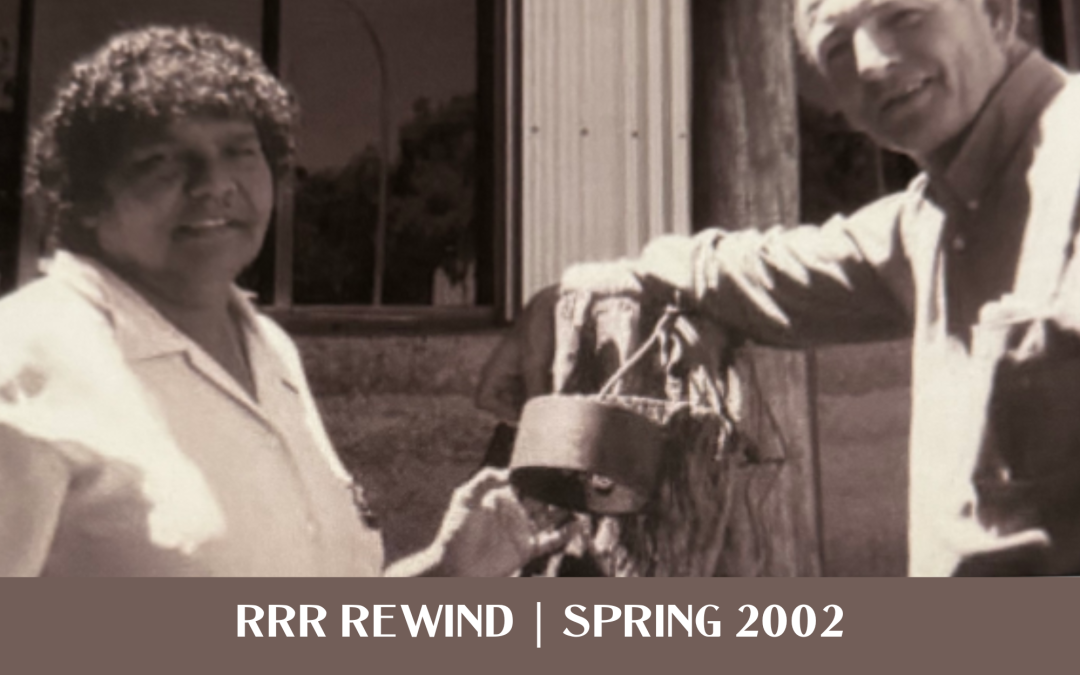Written by Estelle Blackburn for the RRR Newsletter | Edition 21, Spring 2002
Josephine Farrer is the President of the Halls Creek Shire Council, the first and only Indigenous woman to hold such office.
Josephine is responsible for an area two-thirds the size of Victoria and a population of 3,800. She now presides over the authority that in the 1960s segregated her and her people from Halls Creek, restricting them to camps on the outskirts and limiting their access to the town. It was her indignation at the difference between Indigenous people and what she describes as the white intruders that drove her to make Australian history by becoming Shire President.
Josephine was born under a tree somewhere between Moola Bulla station and old Halls Creek and spent her childhood in the bush on the station, living off the land in traditional style. She was named Jarlarlmyn and spoke the Gidja language. She first went to Halls Creek at the age of 9, when Moola Bulla’s Indigenous people were rounded up and sent off the station to live in camps on the outskirts of town. The Shire was then dominated by pastoralists and Josephine started to ask questions, just as she had asked her mother on Moola Bulla about the difference between her family and the people in the homestead.
Living traditionally off the land, it was a long time before she was aware of the homestead and its lifestyle. The first building she saw was at five years of age, when the mob of station kids were gathered up, taken to the shelter called the station school, and taught to sing God Save the Queen for the coronation in 1952. After that, she stayed near the shelter and attended school, which consisted of one class taught by an English couple. Being close enough to the homestead then, she was given some domestic work.
She had to get up at 4am to milk the goats, take the milk to the homestead for breakfast and clear up afterwards. That was a requirement of Indigenous children living on their land, which had been taken over by the pastoralists. Moola Bulla station was sold three years later and the kids were herded onto the back of a truck and taken miles away to Fitzroy Crossing. They were put in United Aborigines Mission dormitories in a fenced area and in a classroom with one teacher.
Josephine can’t remember when she left school because she missed so much of it. Homesick for their parents, the children used to run away all the time, making their way home to the station. But the school functioned. Had she known what ‘gifted’ or ‘bright student’ meant, she acknowledges that she would have fitted that description. She married young in traditional style and had nine children of her own, being ‘Mum’ to many more in the Indigenous cultural tradition. After the family had lived in the Halls Creek camps for some years, they were finally offered a house. Not accustomed to living under a roof, Josephine declined twice. When she did accept, she found that getting used to walls around her was one of her biggest challenges.
Settling down to town life, Josephine needed to work to support the children, and she took a job doing domestic duties. Then her curiosity about the difference between ‘them and us’ started to turn to anger. She was advised to fight with words, where they could be heard, and she took that advice, leading to her life in politics and local government.
Josephine stood for the Shire Council 14 years ago and won a seat, giving her a platform to voice and act on her concerns for her people, their culture and traditions.
She has made the most of the opportunity. She was the driving force behind the community radio station, which encouraged the Indigenous community to take an interest in their culture and affairs. In what is described as the most amazing feat, she succeeded in creating a Kimberley Language Resource Centre at Halls Creek to collect, preserve and teach the languages and history which had been passed down orally. She is also passionate about retrieving people’s land artefacts and traditional items taken from her people’s land for museums around Australia, action that she believes broke up the traditional owners’ culture. These include ceremonial costumes of her grandfather, Tommy Windjana, who was a big law-man. Her efforts to retrieve these include preserving the traditional art on Moola Bulla, rock paintings she is concerned will be lost as the rock crumbles.
While Josephine is passionate about her people’s culture and education, she is actively involved in many other organisations and issues too. She is the chairperson of the Kimberley Regional Road Group and the Deputy Chair of the Kimberley Development Commission.
Her voice carries far beyond Halls Creek and the Kimberley. She was recently a WA representative at the Bicentennial Celebrations in Melbourne, and one of three Western Australians selected to represent the State at a number of meetings of the Rural Regional Women’s Advisory Committee organised by Deputy Prime Minister John Anderson.
Fast forward to March 2013, Josephine was elected to the Western Australian Legislative Assembly, representing the Kimberley region for the Labor Party. As the second Indigenous woman to serve in the WA Parliament, she brought a strong voice for Aboriginal communities and regional issues. During her tenure, she championed the Constitution Amendment (Recognition of Aboriginal People) Bill 2015, which was assented to on 17 September 2015, marking a significant step in acknowledging Aboriginal people in the state’s Constitution. Farrer also contributed to inquiries into Aboriginal youth suicide and served on the Education and Health Standing Committee. After serving two terms, she retired in 2021, leaving behind a legacy of advocacy and leadership.

